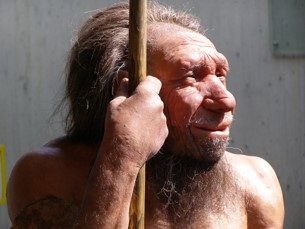
Domingo C. Salazar, Ikerbasque Researcher at UPV/EHU, with Robert C. Power from the Max-Plank Institute of Evolutive Anthropology, have analyzed the dental calculus of Neanderthales to study their diet.
The Neanderthals (Homo Neanderthalensis) inhabited Europe and parts of Western Asia from 230,000 to 28,000 years ago, coinciding during the last millennia with Homo Sapiens, and became extinct for reasons still discussed; in fact, the fate of the Neanderthals has intrigued and continues to intrigue researchers around the world. The most common idea is that the disappearance of the Neanderthals was motivated by greater competition from the ancestors of modern humans, the Homo Sapiens, who appeared around the same time that the Neanderthals were disappearing from Europe, and one of the explanations about how this could happen was the diet.
Se cree que los neandertales tenían dietas más limitadas, mientras que nuestros antepasados tenían dietas más flexibles y adaptativas que incluían alimentos marinos y abundantes plantas. Esta nueva investigación de los fragmentos de cálculo dental o sarro, demuestra que la explotación de plantas también era una estrategia de subsistencia de los neandertales extendida y profundamente arraigada, aunque parece indicar que este consumo de vegetales era limitado a un tipo de planta o vegetal concreto, a diferencia de cómo los humanos modernos se alimentaban. Según Domingo C. Salazar “Esta forma de alimentarse en lugar de ser signo de primitividad, refleja una estrategia que simplemente se mantuvo durante miles de años por su eficacia”.
It is believed that Neandertals had more limited diets, while our ancestors had more flexible and adaptive diets that included seafood and abundant plants. This new investigation of the fragments of dental calculus demonstrates that the exploitation of plants was also an extended and deeply rooted subsistence strategy of Neanderthals, although it seems to indicate that this consumption of vegetables was limited to a specific type of plant or vegetables, unlike how modern humans fed. According to Domingo C. Salazar "This way of feeding instead of being a sign of primitiveness, reflects a strategy that was simply maintained for thousands of years because of its effectiveness".
For more information: Journal of Human Evolution, volume119 (2018), pages 27-41. DOI: https://doi.org/10.1016/j.jhevol.2018.02.009.
.png)
